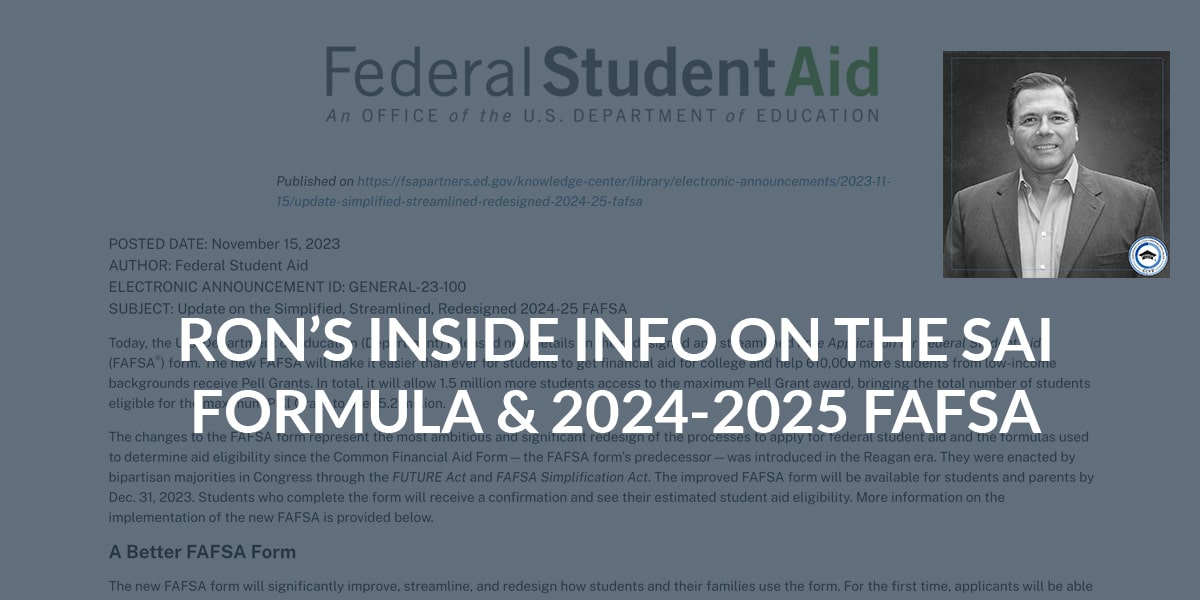Ron’s Inside Info on the SAI Formula & 2024-2025 FAFSA

An Important Update from Ron Them
Hello everyone. As someone with close contacts in the college academic world, I aim to keep all my advisors informed about the latest developments, particularly regarding the new Student Aid Index (SAI) formula and the 2024-2025 FAFSA. The Department of Education (DOE) has kept details about the FAFSA launch largely under wraps. However, insider information suggests that the new FAFSA won’t be public until January 1st. More intriguingly, unlike in past years, students won’t know what aid they qualify for until early February.
Insights into DOE's Planning and Potential Impacts
According to my sources, this delay is to allow colleges to prepare for anticipated errors in the FAFSA and FUTURE Act Direct Data Exchange (FA-DDX), the successor to the former IDOC tax processing system. Interestingly, schools might not be able to access the students' information until late January or early February.
I’m sharing this critical information with you, my fellow financial professionals, so you can guide your clients through the potential chaos during a time when many colleges will likely increase their tuition fees significantly. This situation could present a unique opportunity for college planning and lead generation.
How Financial Professionals Can Proactively Use This Information
As financial professionals, it is crucial to reach out to your clients and prospects to help them navigate these changes. I recommend scheduling personalized consultations to discuss how the new FAFSA and SAI changes specifically impact their college planning strategies. These meetings are an opportunity to:
- Provide Tailored Advice: Each family's situation is unique, and these changes can have varied implications.
- Avoid Common Mistakes: With the new rules, the likelihood of making errors increases. Guiding your clients through this process can save them from potential financial setbacks.
- Optimize Financial Aid Opportunities: Understanding the intricacies of the new SAI formula can help maximize eligible aid.
Call to Action for Advisors:
Encourage your clients and prospects to schedule a consultation with you. Emphasize the importance of being proactive in adapting to these changes and how a personalized meeting can help them be in the best position possible to navigate the new FAFSA landscape effectively.
Key Changes in the Financial Aid Formula (SAI)
Knowing these key changes will help guide you on the practical steps you can take to assist your clients, emphasizing the importance of consultations in this evolving financial aid landscape.
Asset Changes
Significant changes have been made to the asset contribution components of the SAI formula:
- Child Support as an Asset: Now includes the annual amount of child support received, a shift from its previous categorization as income.
- Business Net Worth Reporting: Expanded to include all business sizes, not just those with over 100 full-time employees.
- Farm Net Worth Calculation: Now encompasses the value of a family farm, with the primary residence still excluded.
- Education Savings Accounts: For dependent students, these accounts are considered a parental asset if designated for the student.
Advising clients on these asset changes is critical. They could significantly impact families, particularly those who cannot easily liquidate, or borrow against, assets like businesses or farms to pay for college.
Other Changes
- Retirement Account Considerations: Deductions and payments to self-employed retirement accounts are now counted as untaxed income.
- Family Members in College: This factor has been removed from the SAI needs analysis, potentially doubling the cost of college for families with multiple students enrolled simultaneously.
It’s essential to discuss these changes with your clients, particularly those who are self-employed or have more than one college-bound child, as these updates could drastically alter their financial planning for college.
Call to Action Message for Financial Professionals
To all advisors with college-bound families reading this: the landscape of college funding is changing. I urge you to reach out to your clients and schedule in-depth consultations. These discussions are not just about adapting to the new rules; they’re about seizing opportunities and avoiding pitfalls. Your guidance could make a significant difference in your clients' educational funding strategies.
Stay Updated
As we move forward into this new era of college funding, I will continue to provide updates and insights. Keep an eye on our blog for the latest information and strategies to help your clients navigate these changes successfully.
Remember, your role as an advisor is not just to inform but also to empower your clients with the knowledge and strategies they need to make the best financial decisions for their families' futures. Let's work together to ensure they are well-prepared for the challenges and opportunities that lie ahead in the college-funding landscape.
Posted by Ron Them
He is a former Chief Financial Officer of a Fortune 500 company and currently owns his own financial advisory company specializing in cash flow planning for business owners and executives. He developed the Cash Flow Recovery™ process that uses cash flow management principals to increase asset value and build wealth for business owners.
He is also the originator of several software calculators to help advisors and families make college affordable, including:
* College QuikPlan EFC Calculator
* "Find the Money" College Cash Flow Calculator
* College Debt Reduction Calculator
Ron has been quoted in U.S. News and World Report, Kiplinger's Personal Finance, Smart Money, Financial Advisor Magazine, Small Firm Profit Report, Practical Accountant, LIMRA's Market Facts, Senior Advisors Magazine, HR Magazine, BenefitNews.com, Employee Benefit News Magazine, ProducersWeb.com, Entrepreneur Magazine, Insurance Selling Magazine, CollegeNews.com, The Christian Voice, and Columbus CEO Magazine.
